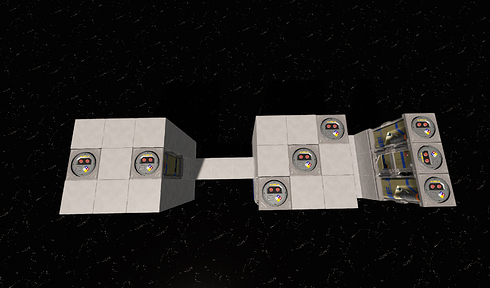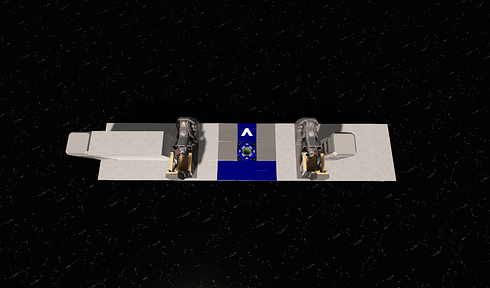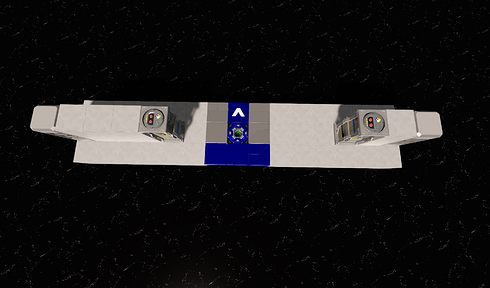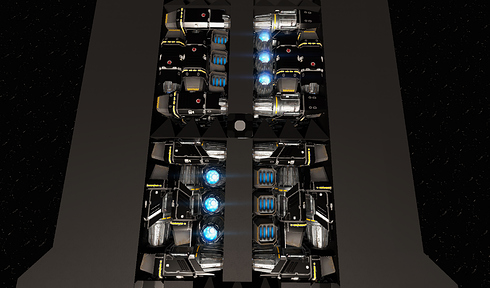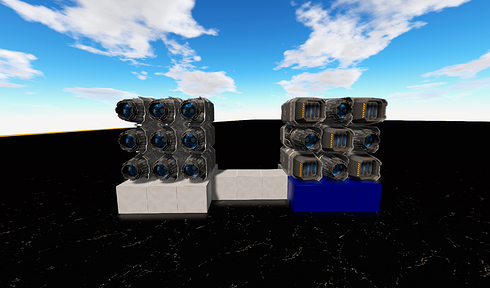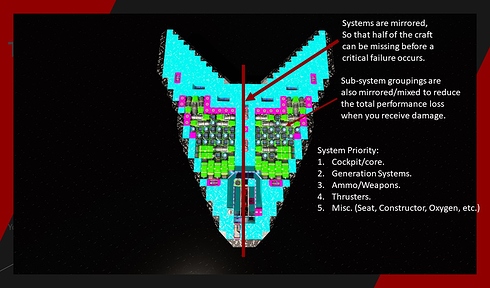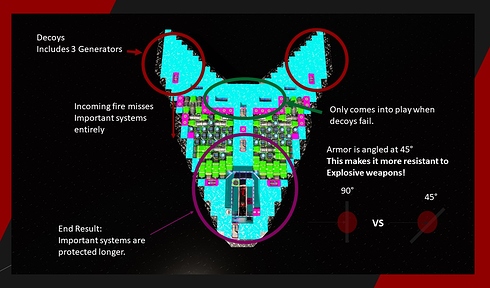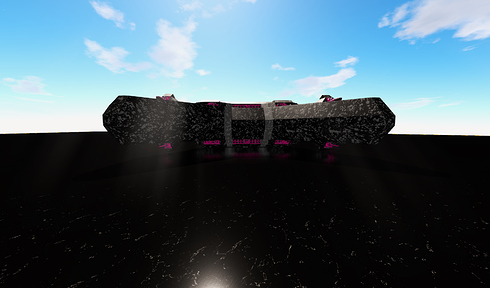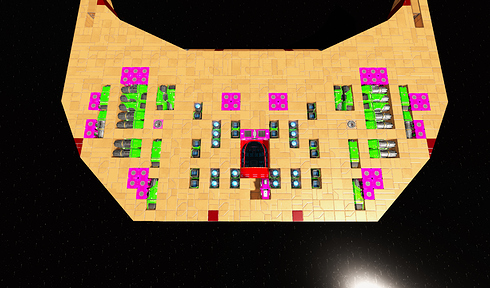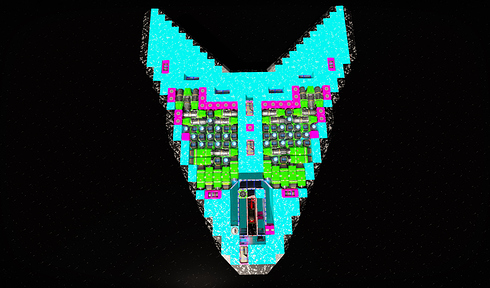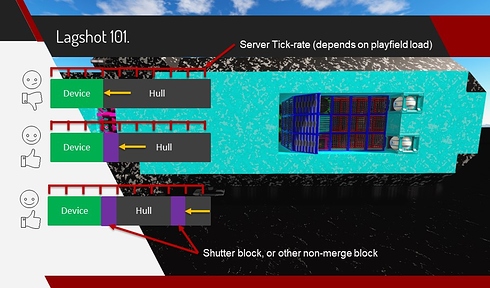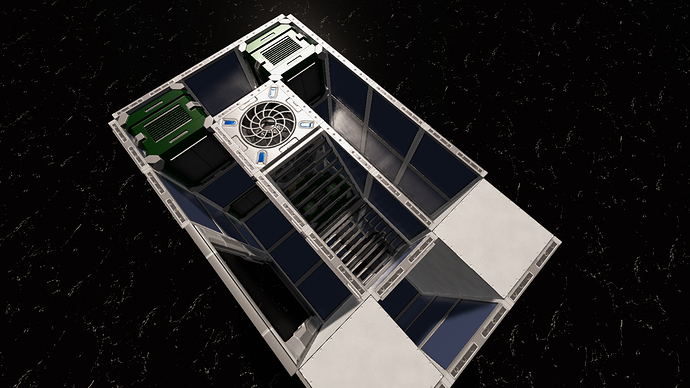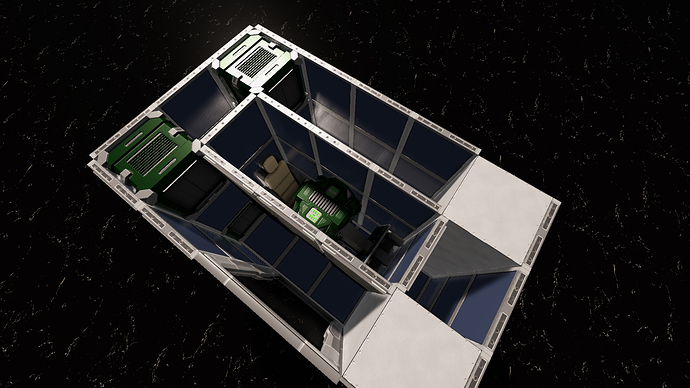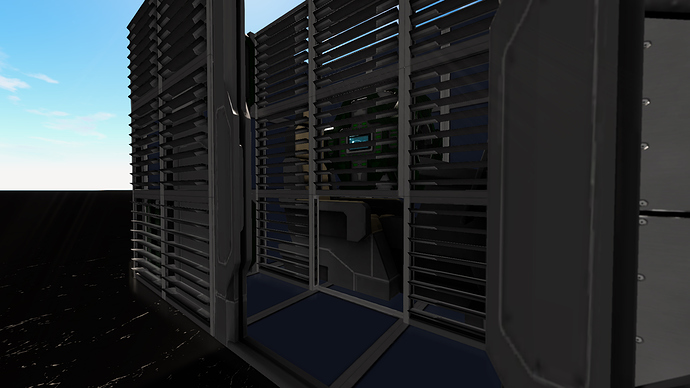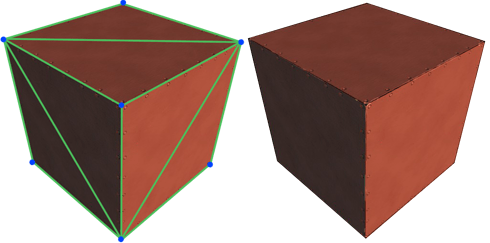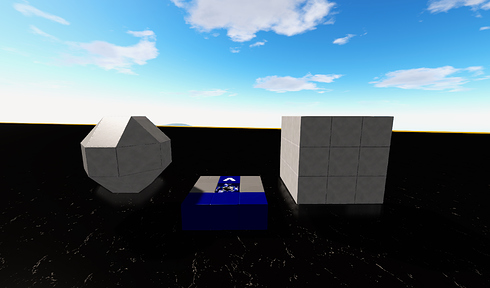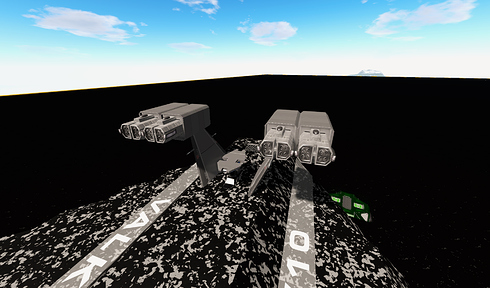Chapter 1. System Design.
Hello and welcome to the SV design guide! I’m your host Zackey_TNT!
This guide is outlined by 4 chapters and their respective subsections. These will contain everything you need to know to get started on pvp!
Please note:
This guide assumes you have some experience with empyrion, and while great care has been taken to get all the facts right, the game does update from time to time, and I can make mistakes too!
If you’re needing a quick reference or just want to know some basics, check the FAQ below!
Quick FAQ
Q: How much thrust and rcs?
A: It depends on your craft or style of gameplay, but in general you should strive for a minimum of:
30m/s² In all directions
1.5 Degrees /s+ for rotation in all directions
Q: How many blocks?
A: It depends on the craft but always strive to build to the limits. Current limit is 3K blocks. There are designs out there that have been successful at 2k-2.5k blocks. These are rare and made by experienced people.
Q: What’s the best block to stop lagshot?
A: Shutters, across the board. It’s because they aren’t counted as a device, and don’t merge as a block face. They also resist lasers, thanks to EWS. Check “Chapter 2” for detailed overview.
Q: What is the maximum class size for Golden Globe?
A: The maximum class size, as of writing this, is 1.49. We recommend you stay below 1.48 to prevent being “taken” See Chapter 3 for details.
Q: How do RCS blocks work?
A: RCS work by applying force to each axis. It depends on their torque value as to how much they offer. Eventually, the weight of an additional RCS block will overcome their rotational torque, so there is an element of diminishing returns, but this is rare. They have a very minor buff if you place them on the axis you wish to rotate, it’s so small that most pvp players ignore it.
Q: How do thrusters work?
A: They simply add m/s² to the given axis that you have them pointing based on their thrust force. Remember that it’s squared, not a flat value. You need an absolute minimum of 17 m/s² to get off the ground on GG, do not ever go this low! Always aim to be above 30m/s²
Q: Jets or Medium Thruster?
A: Jets, always jets. Specifically, the 1x3x1 jet. This provides the best overall statistics and is superior to other types of thruster.
Q: What power percentage is acceptable?
A: Aim to be below 95%, if your power generation goes over 100%, your craft will use more fuel. 95% should provide enough buffer so that when you lose a generator, you also lose a thruster or power drawing device.
Let’s start off with:
Common Mistakes
Firstly, chain reaction:
Chain reaction is what happens when you have placed an explosive block end on end. For example you place a row of fuel tanks, and one of those fuel tanks exploded due to an enemy shell, the entire line explodes.
Now, to fix that, we only need to add one hull block between our fuel tanks to prevent them from reacting on each-other.
Let’s look at an example:
Only the very left setup will avoid a chain reaction. Yes, that’s right, even the middle one, which appears to have blocks in-between, will explode in a blaze of glory!
Targettable blocks next to the cockpit:
This is another common mistake many designers make. Placing something that turrets can target right next to the cockpit. The problem this causes is obvious, it draws fire directly into the cockpit.
Example:
In order to stop fire from killing the cockpit, we need at least 3 blocks seperating the generator from the cockpit, as seen on the left. This isn’t to say that’s ideal. In an ideal world we wouldn’t have generators anywhere near the cockpit at all! But space limitations make that difficult!
Decoy Flashback:
Decoy flashback is what happens when you have multiple devices within flashback range of a targettable block. It happens because whenever you take fire from a turreted vehicle, there is always more then one shell targeting that block. Turrets do not track independently, they will always target the same block on the same vessel.
Let’s look at an example.
Here we see on the left proper separation of decoy and device, and on the right, both devices will be destroyed when the generator gets targeted.
This also applies to thrusters, because they are targets too.
You can see that if we take a hit on the left or the right, we will have damage spread into each compartment. Also note the system priority, this will become important when we reach subsection 3, which will detail the final assembly of systems.
We can fix this very easily by adding 3 blocks in between. This is the absolute minimum required to stop 2-3 shells. Which is about what we need to stop.
And now onto the the guide:
Subsection 1. System Mixing/Mirroring.
System mixing is a process in which you carefully mix your systems to provide maximum redundancy. It’s useful because it prevents premature death by losing one entire axis of movement if your thrusters should be compromised. It applies mostly to thrusters but can also apply to fuel tanks, generators, and other block types.
Example:
If we took a hit on the left, we would completely lose an entire side of our thrust. This is bad. We can see on the right, that if both systems where mixed, we would only lose half of our thrust in one axis.
Here is a fighter that is employing this technique:
Please note this SV could do more system mixing, but for the purpose of this guide, we will be using a declassified PVP design called “Valkyrie V10”
It is also important to mirror your entire craft so that even if you lose one whole half of your ship, you are still able to fly away to safety. Here is an example using an old training slide I created:
You can see that all systems are perfectly symmetrical, and that’s important to ensure maximum durability.
Subsection 2. Decoy Systems & Armor Angling.
Decoys:
One of the most important things to have on a pvp fighter/tank/capital vessel is good decoy systems. Decoy systems draw fire away from important devices such as thrusters, fuel tanks, and your cockpit!
They are usually made out of generators, because this is the most common block people target with turrets! Some also use thrusters, guns, or hell, even warpcores! Anything that can be selected as a target can be used as a decoy, just remember, think “Would I target this block, or leave it alone?” Many PVP players ignore thrusters, because they tend to be a block type we have many of.
Please note that while a purely anti-sv ship might seem logical to ignore decoys, there are many cases in which such a craft might stumble into turret range, so having an effective decoy system in any craft is important!
Armor:
First let’s start by saying that more armor (hardened steel) is better. But we can only have 3,000 blocks in GG, so we have to make the most of it. Where you place your armor may vary, depending on your hull shape, but all pvp designs will have a good amount of frontal armor, and this is where we want to place our decoys.
When placing decoys, you also need to be careful not to over-saturate your armor.
The more generators (or devices) you place internally, the less effective your ship’s armor becomes. This is because a generator takes up two blocks, which means that 250 health is split between two blocks, where as with armored steel, we’d have 400 health in the same area.
Not only that, but if we spread our decoys around, we’d be able to use more of our armor to soak the damage, instead of just one area being compromised and then swiftly destroyed!
We only have a limited amount of devices we can spend in pvp, and using them all up on decoys that aren’t going to increase your endurance doesn’t help!
Armor angling externally is also important. In Empyrion, explosive weapons are radius based, so if our armor is angled at 45 degrees, more of the radius is going to be “vented” off into air. It’s a minor part of pvp design, but that’s what makes great players… great!
Let’s look at an example of all of this:
Now, don’t forget weapons are targettable blocks too! On the valkyrie, they are placed just behind the decoy systems, so that they are hit after our decoys fail. Better to lose weapons then to lose all power!
The weapons, marked in pink, are placed so that when fire is drawn into them, it is away from our core systems.
Remember our system priority?
- Cockpit/core
- Generation systems (Your final generators not used as decoys!)
- Ammo/Weapons
- Thrusters (We have lots to lose!)
- Misc (Seats, o2, constructors, anything we can live with out!)
When placing decoys, remember these rules:
- Is is going to draw fire into something we can’t live without (See above priority!)
1.5. If I received fire from a different direction, would it pull fire into something we can’t live without? - Is it going to spread the damage across my armor equally?
- Does it actually help me with endurance?
You can always test these rules with your own private server. Turrets are always going to behave the same way across empyrion, the only thing that will change is how long your armor will hold up because of damage values.
Subsection 3. System Placement & Layouts.
Deciding where to place fuel tanks, thrusters, and other devices is a very important part of design. Fundamentally, you should:
- Place explosive devices away from eachother, and other devices.
- Place targettable blocks away from things that explode.
- Place important things like cockpits deep inside your hull.
- Make sure you don’t run out of devices you need (gens, fuel tanks, weapons, cores)
By now you have learnt how to use decoys, how to system mix and mirror, and how armor works. Firstly, let’s discuss Clustered vs Grouped.
Clustered System Design is the age old tried and true method of protecting your systems. It involves bulk-heading absolutely everything off from eachother such that they form “clusters” of systems around your ship.
Here’s an example:
You can see that all of the thrusters are in little “clusters” around this ship.
Thanks to Abrum13 for providing his example!
Grouped System Design is my preferred method of building, and has only recently became a really driving force in the PvP meta, thanks to the ever increasing need to be triangle efficient!
It involves grouping everything similar into one area of your ship. So thrusters go into one or two compartments, RCS blocks go into another, and all systems are protected more easily.
Here’s an example:
You can see quite easily that all of my thrusters are in the same area, albeit “clustered” by one bulkhead down the middle, designed to protect the cockpit area.
So which one is better?
Well, here’s the pros and the cons:
Clustered:
- +More redundancy.
- +More Tanky.
- +More Difficult to locate a single area to focus fire on.
- +Less likely to fail (requires less “balancing on the edge”)
- -Less Triangle Efficient.
- -Harder to Update.
- -Less Flexible.
- -Requires more space.
- -Usually slower & statistically inferior to grouped.
Grouped:
- +Easier to update
- +Usually faster & statistically superior
- +Requires less space
- +More Triangle Efficient
- +Flexible & applies to almost all hull shapes
- -Easier to pinpoint a location to shoot
- -Harder to master, often failing spectacularly
- -Not as durable
- -Often requires armor managing during combat.
I personally prefer the use of Grouped, because of the above pros.
Whatever method you decide to use, follow these suggestions:
-
Use your thrusters to protect your more sensitive items (cockpit, core, etc) as they have quit a bit of health and there is a lot of them. They can also be effective at stopping SOME lag shots, not all.
-
Place your decoys on the extremities of your craft, or around your main system area, so that you pull fire around your craft instead of into it.
-
Don’t be afraid to experiment with placing fueltanks and RCS blocks inside your thruster groups, sometimes it does pay off, just make sure they can’t chain react.
-
Make sure you have redundancies of everything. I like to have at least 10 generators and 10 fuel tanks. A good rule of thumb is to have 1 fuel tank for every generator, since you need both to have power.
-
Have your cockpit centrally mounted in the most armored part of your ship, this will provide the greatest protection. There have been designs in the past that experimented with this, none of them worked particularly well. At the same time, try to make it not obvious where you get in and where your cockpit is.
-
If you have to have PVE elements (Passenger seats, constructors, armor lockers) try to treat them as low priority blocks. They aren’t very important during combat and can be used as extra armor or throwaway lagshot defense.
-
If you MUST have a warpcore treat it as an optional device that is expendable. Don’t compromise your survivability for it, you can always just hop out and place one on the outside of your ship for escape. Remember, it’s a targettable device that takes up 3x2x5 and also only has 250 hit points.
Chapter 2. Protecting from Lagshot.
Countering lagshots is one of the most important parts of PVP, without lagshot armor, you’d be dead in a matter of seconds, and I mean that!
Subsection 1. Understanding Lagshot.
What is lagshot? Lagshot is what happens when you take a bunch of players and have them shoot at each-other. You create lag, and these projectiles the players are firing lag too. In a sense, they clip through any block that’s merged, due to server slowdown. Instead of impacting the outside of your hull like they should, they clip through and hit the next surface they find, which just happens to be our devices… how annoying!
Blocks in Empyrion merge as part of their optimization, hull blocks in particular are extremely good at merging. You can notice this by texture patterns and the fact that when you clip into a ship, you can see the devices.
This might be good for optimization but it’s terrible for lagshot. Whatever you can see in god-mode when you clip into the hull is what lagshot will eventually hit, given enough server slowdown. So, given this, we want to stop lagshot by using a block that does not merge with the hull, or each-other.
We need a device that is durable enough to take repeated projectile fire, won’t merge with the hull, and will catch our pesky lagshot projectiles. Great! Let’s just use RCS (or insert device here)! Erm… there’s a few problems with that, least of which is that you need RCS to turn! RCS blocks are counted as a device, therefore, they will raise the class size greater then simple hull blocks. Secondly, they have very little health and explode for 5 damage to each block around them, making the situation worse!
So we need a block that meets all of the requirements above… but doesn’t get counted as a device… What to do?
Shutters. Shutter Windows S are perfect. They don’t merge, they have the same amount of health as our armor, and they aren’t counted as a device! Brilliant!
Here’s an example!
Sidenote! Shutters might be the same health as our hardened steel blocks, but they are in the “Hull Combat” category! Therefore, they aren’t good at stopping splash damage weapons! So, don’t put them on the outside of your ship!
Let’s move onto subsection 2!
Subsection 2. Core Design.
Now that we know about what causes lagshot, and what stops them, let’s start spamming shutters everywhere! Well, hold on there buddy. Shutters are good because they aren’t merged, and non-merged blocks use alot of triangles. The very reason we use them is the very reason we can’t use many. The more you place, the more insane your triangle count gets!
Therefore, we need to prioritize what we protect! So, we need to protect blocks that we only have 1 of, because we can add redundancies for the rest, that would happen to be your core, cockpit & yourself!
Here is an example of a good layout for a cockpit area. Top has been removed.
Note that the bottom middle of the cockpit shutter has been removed, this will allow players to properly get in and out of the ship as per patch 9.1 requirements.
Bury this deep inside your hull and route a little corridor into it, and you’ll be well protected. If you have extra triangles, consider reinforcing the shutters around your cockpit by adding additional shutters, or protecting your core groups from lagshot.
Here’s the EPB.
CoreDesign.epb (128.7 KB)
Chapter 3. Optimizing our hull.
Triangles are equally important for PvP, it’s the largest skill-gap in the game, due to the complex nature of it. Let’s dive in!
Subsection 1. The Class System.
Empyrion’s limits are based on a class system which calculates how performance impactive a craft is based on a equation (which you can take a look at here, thanks @RexXxuS)
Now what this means for us is that we have a limit of how many triangles we can use. Since PvP ships don’t use lights, because they increase the class limit, and we can’t optimize devices, this means triangle are the single most important part of PvP design.
On Golden Globe, we have a class limit of 1.49. Anything that goes over this will be taken by the hostile faction “HWS” which will cause our craft to become red to all our allies and bases. Ontop of this, if you continue to use an HWS taken vehicle in pvp, you are liable for punishment, because it’s against our community rules.
To prevent this, we need to build some buffer space for our ship to grow into, or “upclass”. Usually 1.46 is a good maximum to build to. But some like to tempt fate and go as high as 1.48. Number one rule however is never build at 1.49, because you will have no room what so ever to grow.
So why does upclassing happen? It’s rather simple, each time a block is removed in your hull, it’s revealing the block behind it, above it, and to the sides of it. That increases your triangle count and before you know it, you’re overclassed. The reason we build the buffer in is because eventually, you’ll take so much damage that a device will be destroyed, which means your class will reduce quite a bit.
Should the worst happen, and you end up getting warnings for upclassing, act quickly! Get a multi-tool out and start stripping off devices, they have the highest class impact on an SV, that means weapons. Once you have the class back under 1.49, you can repair to template so that the ship is back to normal.
Right, now that we know why triangles are important, and what a class size is, let’s get onto subsection 2.
Subsection 2. Optimizing Triangles.
In order to optimize triangles, first we need to discuss what a triangle is.
A triangle is how the game renders visual objects. It’s a texture map to the surface of a block. In any given block face, it will use about 2 per surface. Assuming it’s a cube.
Here’s an example:
In this example, you can clearly see how the triangle is mapped to the surface of the block. Knowing this, we can look at a wedge:
We can immediately see the clear benefit of using a wedge over a block, it uses less triangles. And this is the same with things like corners and cut corners, so we want to round every edge we can, to minimize surface area!
Here’s an example of a rounded cube:
The one on the left is way more triangle efficent then the one on the right, and has the same number of blocks. Furthermore, the internal volume of the cube still remains (one block) so we have a better surface to internal area ratio.
The more optimized your hull is, the more devices and shutters you can take advantage of.
So, in short, we want as little surface area as possible. We want to cover as much of the surface as possible with wedges, and corners, and we want to make sure our shape is already light on triangles.
As an example, let’s optimize an old fighter of mine:
And here it is semi-optimized (Blocks marked in pink):
Because our corners where revealing half a surface from the block below, we replace them them with a Corner Large A, which attaches efficiently to our current setup and covers the surface below it.
If you are still confused on triangle optimizations, take a look at this TAW video I produced a while ago, called “The Box” at this link:
https://youtu.be/PGrq88ufOIc
Chapter 4. Weapon Placement & EWS.
In order to understand what goes where, we first need to discuss EWS.
Subsection 1. EWS & Weapon Priority.
EWS is HWS’s custom config file for damage resistances. It’s an integral part of the PvP meta. What it does is change all the blocks to be in certain categories, which the weapons have different multipliers for. An example is the Homing Rockets for SVs, they are “effective” against “Hull Armored and Hull Combat” which means they receive a 10x damage bonus to that category! However, they only do base damage against other block categories, receiving only a 1x multiplier against those categories.
You can view the EWS config here:
EWS Config
What this means for us is that we need to prioritize our weapons in order to figure out what we should protect the most, and what is expendable.
Here is the list:
- Pulse Laser. They do base damage to all categories except Metal and Hull which they are effective against. This means lasers are our most rounded weapon. (They also lagshot lots)
- Homing Rockets. They do base damage to all categories except Hull Armored and Hull Combat, which means they are great against hull. They don’t cause too many lagshots however.
- Railguns. Railguns are great at damaging devices once the hull has been stripped, they are however not effective against all hull types. They are also difficult to aim.
- Rocket Launchers (Dumbfire) These only do effective damage against base blocks, and are difficult to hit with.
- Plasma Launchers . These are invaluable against slow moving ground targets, but do not track fast movers very well, so they are our most expendable weapon.
Sidenote: All weapons are valuable, and we should always remember weapons should be lost only after our decoys have failed!
Let’s continue in subsection 2.
Subsection 2. Weapon Placement.
Now that we know the priority and damage resistance system, we can put our weapons in locations that make sense. We also need to have our Anti-SV weapons as close as possible to our crosshair in order to make it easier to aim them.
Weapons that should go on the top of your craft, from furthest forward, back:
- Railguns.
- Homings.
- Pulse Lasers.
Weapons that should go on the bottom of your craft, from furthest forward, back:
- Plasma Launchers.
- Dumbfires.
Sidenote: Some people like to put plasma launchers on the top and the bottom, so that our anti-sv weapons are saved for longer. Some people also like to switch this loadout around, but that’s ok! It all depends on your hull shape, remember, this guide is best guess best attempt, it’s designed to be a suggestion, not a rulebook!
Some of you might have noticed I didn’t mention Gatling’s, that’s because… We use them as weapon armor! Yes, you heard me right! Gatling’s can’t be targeted by turrets on HWS, and they are only effective against players, so they aren’t very useful against SVs, however, they are extremely useful as armor to separate our weapons because they are resistant to splash damaging weapons, and they have a large healthpool (700, as of writing this)
Which of course means that they are better then the 4 blocks they take up (only 100 health less then 4 blocks, and they have better resistances!), and save us on block count.
Here’s an example:
If you didn’t use them as weapon separators, then you could use them as some extra armor on the front of your SV! Just be mindful of triangles and the fact that it’s an extra 6 devices!
Here’s a little trick for all you aspiring PvP engineers, you can use wings to extend your weapons out from your hull, without breaking the rules! Be careful of the class they take up, and be aware they cause you to rotate slower, due to increasing your dimension!
Remember, always keep current on the server’s rules, that way you can avoid punishment. If you’re not sure, ask a server admin or curator!
And that’s it folks, the end of our guide, but we have one more thing for you!
PvP Craft Download.
That’s right! A gift to get started!
A copy of my tried and true Valkyrie Fighter.
Before you download it, please review:
Flaws & Overview
The Valkyrie Fighter was The Art of Warfare’s main SV fighter for season 8.1, 8.7, and the first part of season 9.
It comes from a time when Multi-role was the way to go and is designed with newer players in mind.
While TAW has moved onto other designs, this fighter will help you get started!
While outdated, it is considered a “current” design in that many of it’s key aspects are still up-to date. The flaws are as follows:
- Cockpit Entry is outdated.
- Fuel Tanks are outdated (gets fueltanked quickly)
- Due to lagshots, RCS can get killed quickly.
How you fix these flaws is of course up to you, or if you’d rather just use it for an example, feel free!
Valkyrie S9.0-V10.epb (6.8 KB)
When the design becomes too outdated to be useful, I will release the latest we have now. Unfortunately, the nature of PvP prevents me from freely sharing all of my latest craft, but I assure you, if you have read all of this guide, you are up-to date with the PvP meta.
